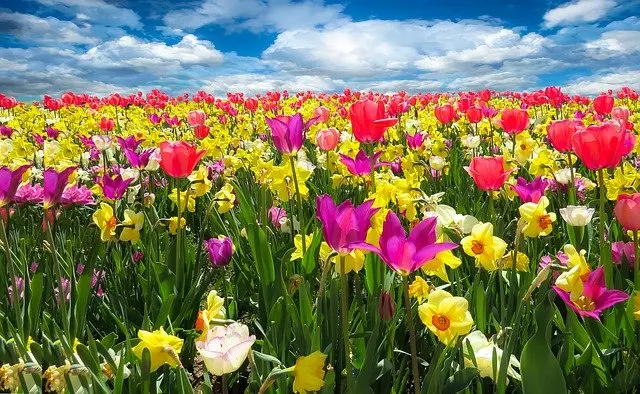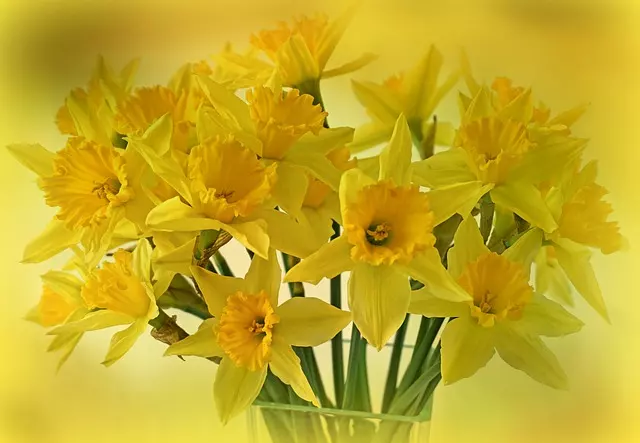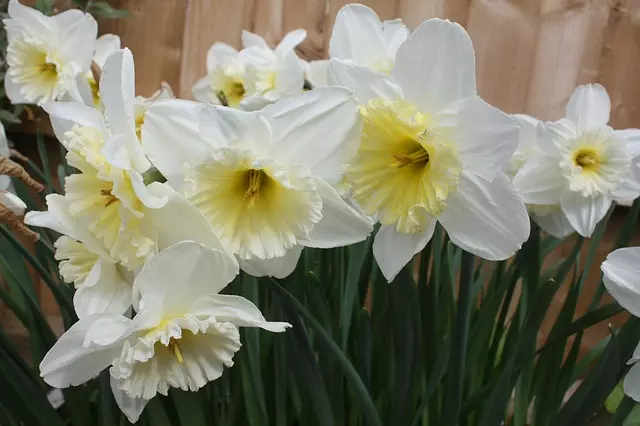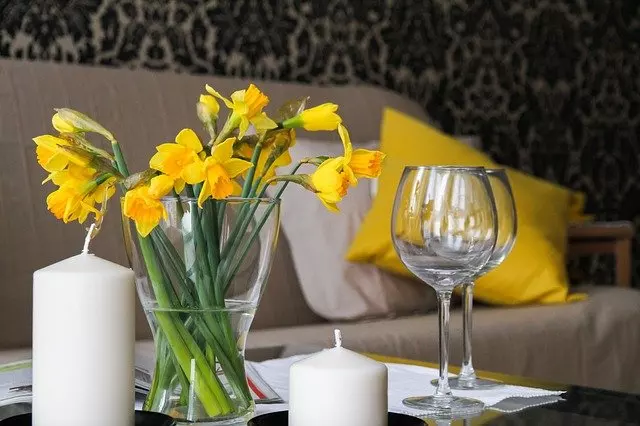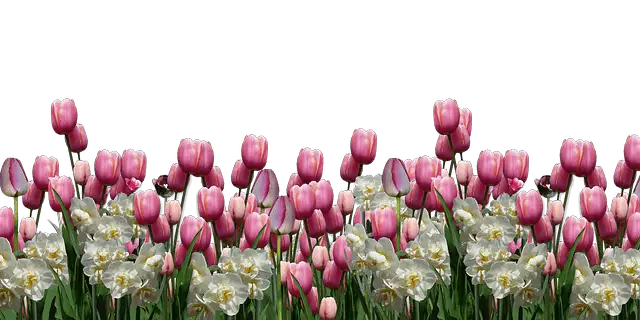One of the most attractive flowers to enjoy in spring is the Daffodil flower, also called Narcissus. With their different varieties of colors, Daffodil flowers have become a classic of garden landscaping. In this article, you will find the most complete guide about planting Daffodil bulbs, the meaning of Daffodil, and how to spread Daffodils every year.
Table of Contents
Daffodil Meaning
The Narcissus flower (also known as Daffodil) is named after the Greek legend about a very handsome young Greek man named Narcissus. Narcissus is punished by the Gods for his vanity. It is the Goddess Nemesis who tricks Narcissus into looking at his reflection in the water, trapping him in his own vanity.
Narcissus falls in love with himself to such an extent that it is not even possible for him to touch his reflection for fear of harming it, and ends up losing his life on that shore.
Metamorphosis of Narcissus
Narcissus died on the shore of the waters. Once his corpse is consumed, beautiful flowers begin to grow and forever bear the name of Narcissus.
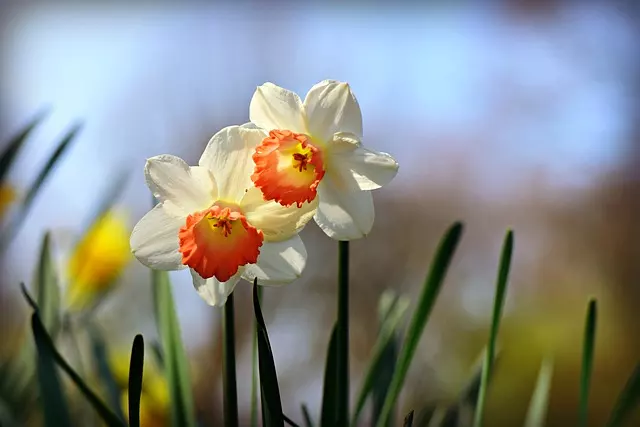
What Does Narcissus Mean
Giving Daffodils (Narcissus) as a gift, although out of love, can indicate that the behavior of the person receiving it has been too vain, selfish, or cruel.
Narcissus (Daffodils) can be given as a farewell to unrequited love, as a closure to the pain suffered by that person.
Daffodil flowers can also mean that this person has a beauty superior to others, indicating a very strong action.
The Meaning of Yellow Daffodils
Yellow Daffodils are the most popular. Shaped like a trumpet, it announces the arrival of spring. It is a flower that quickly overcomes winter, it is strong and symbolizes overcoming obstacles, the arrival of success and wealth.
The Meaning of Violet Daffodils
Violet Daffodils is more associated with Greek legends, so it means selfishness. From another perspective, it is a flower that can help you improve your self-esteem, so it can mean self-love and motivation to take care of yourself.
They are very suitable for people who want to overcome bad habits, bad habits, or overcome themselves.
The Meaning of White Daffodils
White Daffodil flowers are associated with purity and virtue, but when it comes to daffodils, it can indicate a desire for transformation. A guide that leads people on the right path, away from selfishness and vanity.
Meaning of Salmon or Orange Daffodil
Orange Daffodil flowers are related to joy, enthusiasm, and vitality. Daffodil with this shade represents motivation to overcome negative energy, make time for yourself, relax and enjoy the joy of life.
Learn about planting Daffodil bulbs daffodil in this article. If you like the meaning of Daffodils and want to have them in your home, you should be careful because it is a plant that requires special care to keep it beautiful.
Daffodils are one of the most cultivated bulbous plants, along with tulips. Easy to naturalize in the ground and exquisite in taste. Daffodils flowers are a pleasing sign that spring has arrived. Plant the bulbs in the fall and the flowers will bloom in late winter or early spring. Daffodils are hardy perennials and easy to grow in most areas. Their attractive flowers usually bear showy yellow or white flowers with six petals and a central trumpet-shaped corona. Daffodils are suitable for planting between shrubs or for planting in a border, or for forcing blooms indoors. They also look wonderful in a wooded garden and large groves.
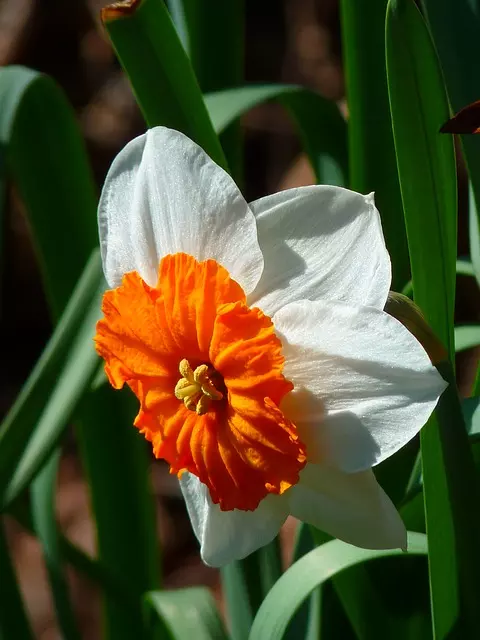
When to Plant Daffodil Bulbs
Daffodil Bulbs are planted in the fall and bloom in early spring. Do not plant them too late.
When To Plant Daffodils In Massachusetts
In general, it is advisable to plant daffodil bulbs in the fall before frost. However, each state in the United States has widely varying climates and temperatures due to the size of the territory. So our readers ask us questions like: “When To Plant Daffodils In Massachusetts“. And the answer when to plant daffodil bulbs in Massachusetts is when the fall cold has set in but when there is no risk of frost.
Frosts in Massachusetts begin on October 8 and last until about May 4. Therefore, we recommend planting Daffodils In Massachusetts before the first week of October, in late September. And if you want to plant daffodils in Massachusetts in October, we recommend covering the soil with mulch, bark, or tarps, to prevent the bulbs from freezing with the first frost, at least until they have adapted to the environmental conditions.
When To Plant Daffodil Bulbs In Arkansas
Our readers in Arkansas ask us “When To Plant Daffodils In Arkansas“. To avoid the effect of the first frost on daffodil bulbs we recommend not planting daffodils in Arkansas after October 31.
In Arkansas, the frost period extends from approximately October 31 to April 1. Planting daffodils in September in Arkansas is not recommended as there may still be sporadic days with high temperatures over 80 F, even in late September or early October.
The perfect time to plant daffodils in Arkansas is mid-October in central Arkansas and early October in northern Arkansas bordering Missouri and Oklahoma.
When Daffodils Bloom In Massachusetts
When Daffodils Bloom In Massachusetts? In Massachusetts, daffodils bloom between May and early June.
When Do Daffodils Bloom In Arkansas?
When Do Daffodils Bloom In Arkansas? In Arkansas, daffodils bloom between mid-April and early May.
We recommend these quality daffodil bulbs (Order it here) or (Order it here).
- Each mix is unique and promises to provide the bright cheery spring colors everyone loves so much!
- Narcissus are easy to grow in well-drained soil in full sun to partial shade and are well known to be deer resistant!
- 12"-16" Tall
How to Plant Daffodil Bulbs
November is a good time for planting Daffodil bulbs in the northern hemisphere or from 2 to 4 weeks before the ground freezes. The bulbs need at least twelve weeks of cool temperatures to take root and bloom normally in the spring. You can order bulbs from many bulb companies in the spring and summer, or buy them at your local garden center in the fall. The cheapest bulbs are cheapest for a reason.
Daffodils grow best in areas with lower winter temperatures. They are not prosperous deep in the south. Most daffodils like full sun and well-drained soil to keep them moist in the spring. Raised beds and hillsides are ideal choices.
Choose the best sandy, well-drained soil. Bulbs do not like moist soil, they are prone to rot and other diseases. When planting daffodil bulbs, dig a hole at least twice the height of the bulb and make sure to place the tip in the hole. Cover it with soil and water! Space the bulbs at least 6 inches apart.
Firstly, select a planting site that is in full sun or partial shade. Daffodils grow best in soils that are moderately fertile, well-drained, and moist during the growing season.
Secondly, select high-quality daffodil bulbs that have not dried out. The larger the bulb, the better. Bulbs should be planted in the fall about 2 to 4 weeks before the ground freezes. Bulbs are planted 1 to 5 times their depth. If winter is severe, it is recommended to cover the bulbs at least 3 inches with soil.
Daffodils will tolerate some crowding but prefer to be 3 to 6 inches apart. It may help to sprinkle a little fertilizer in the hole during planting.
- Deer resistant mixture
- Years of carefree color
- Best buy daffodils mixture
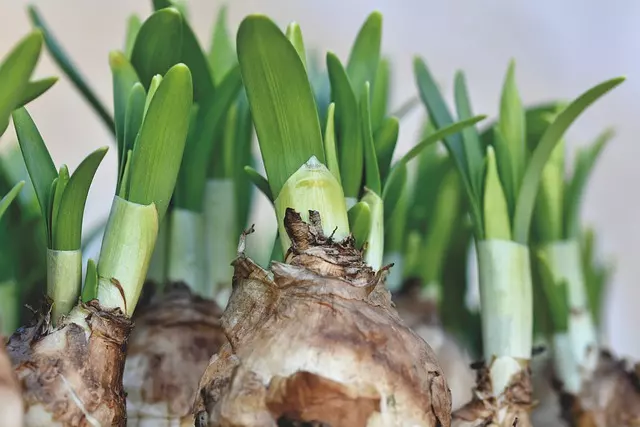
Planting Daffodil Bulbs: More Tips
Then, promote the right conditions when planting Daffodil bulbs:
Temperature: Daffodils require mild temperatures, although they will tolerate low temperatures as long as they are not too extreme.
Light: It requires semi-shaded sites, as direct exposure to sunlight for long periods can damage the flower. Daffodil Bulbs prefer sunny places, but also tolerate semi-shade.
Soil: The substrate should be loose, humid, rich in organic matter, and with good drainage capacity.
Watering: The daffodil is a plant very sensitive to waterlogging, so it requires frequent but not abundant watering to keep the soil constantly moist. Too much water can cause the rotting of the bulbs.
- You will receive (1) bag of 50 bulbs
- Spring blooming, fall planting
- Thrives in rich moist soil
More Tips when Planting Daffodil Bulbs
Sun exposure: Full sun. Type of soil: Clay Soil pH: Slightly acidic to neutral Flower Color: Orange, White, Yellow Flowering time: Spring
Planting Daffodil bulbs and their cultivation is quite simple. The most important thing is to have well-drained soil with a certain richness in organic matter. Excess water would cause the rotting of the bulbs.
Narcissus tolerates cold but avoids extreme cold. If planted in pots, protect them from hard frosts in a dark, cool, and dry place. When the stem is above the soil, take it out to let the sunshine on them, but at night they should be put away again if temperatures are very low.
If necessary, place a stake on the stem, with bamboo sticks or sticks to prevent it from leaning.
The Daffodil bulb will split, producing small bulbs that need to be split within three to five years. In the first year, the bulbs do not need to be fertilized, but you can sprinkle a little low-nitrogen fertilizer (5-10-10) on the soil.
Fertilize again after flowering so that they will have a good start in the second year. The most important thing is: do not trim, tie, weave, cover, or trim the leaves of daffodils after blooming. It takes at least 6 weeks after the flowers die for the light bulbs to make food supplements through photosynthesis.
Wait for the leaves to turn yellow before removing them. Premature pruning will reduce flowering in the second year. You can remove the used flower heads so that the bulb does not spend extra energy to make seeds.
If you have potted Daffodils, you can follow the instructions above and continue to water the plants until the leaves turn yellow, remove the yellow leaves, let the soil dry out, remove the bulbs, and place them in a cool, dry, dark place and plant them in your garden by the end of October or November.
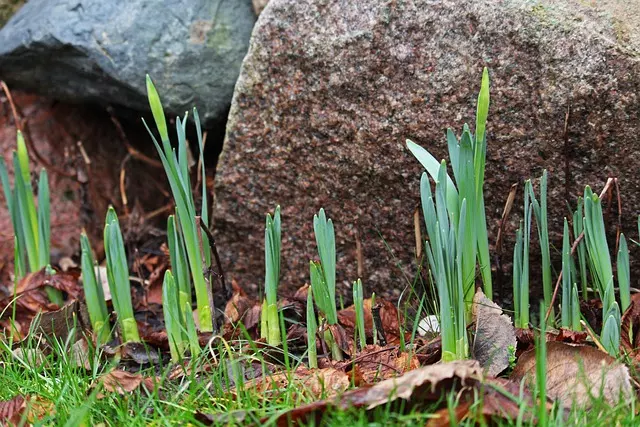
How to Propagate Daffodil Flowers
Daffodil propagation can be carried out by bulb division. This technique consists of separating bulblets (small bulbs that develop at the base of the bulbs). To do this, once the flower has been harvested, the leaves are left to wither for a while so that the bulb thickens and reaches a marketable size. Subsequently, the mother bulbs are separated and the bulblets are replanted. This process should be done year after year until bulbs of commercial caliber are obtained. Finally, they are sorted by size and stored in a cool, dry, and dark place.
When Is the Best Time to Plant Daffodil Bulbs
The best planting time is autumn, since planting at this time, flowering will be in early spring. In the northern hemisphere, the best time is by the end of October or during November, 2 or 4 weeks before the ground freezes.
The best season to plant daffodils is in autumn, long before the arrival of winter, everything will depend on the area where you are located, although the daffodil plant is easily adaptable to different climates, frost does not go very well.
Generally, daffodils develop in any type of soil, but if you want to keep well-developed daffodils with a beautiful bloom, they should be planted in fertile soils.
Each Daffodil has different characteristics and should be planted in ideal soils that can be neutral, alkaline, or acidic.
The flowering of daffodils is at its peak in late winter, but if kept well fertilized they can be maintained for a longer time. Daffodil flowers are large flowers that are best grown indoors; it is one of the flowers of great fragrance. Therefore, this flower is used for making daffodil perfume, having a lot of booms nowadays.
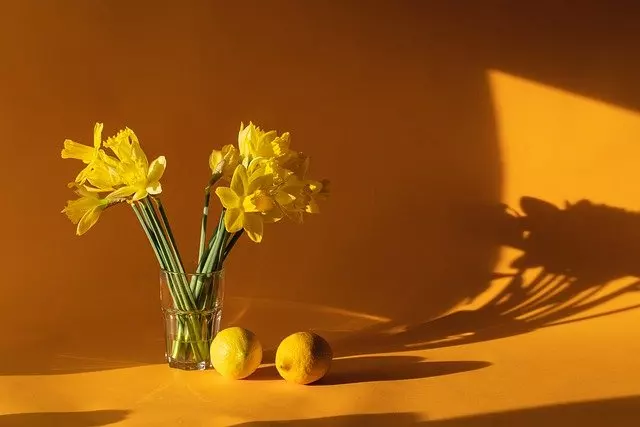
Can you Plant Daffodil Bulbs in the Spring
If the bulbs were activated in the refrigerator or hydroponically and have formed roots, they can be planted in spring.
If Daffodil bulbs do not have roots in Spring, they should not be planted as rooting will not be successful. When bulbs are subjected to cold, they become metabolically active to form roots.
Cold is the trigger for this process. If this stage is generated artificially, for example, in a refrigerator, planting of the bulbs could be successful.
How Deep to Plant Daffodil Bulbs
These should be planted at a depth of approximately 7-8 inches (18-20 cm) and be spaced about 8 inches (20cm) apart. They should also be placed with the bud facing upwards. When planting bulbs, the soil should be moist. Finally, they should be watered abundantly.
Before planting, the soil should be prepared. The soil must be well loosened to favor the correct formation of roots. It is also advisable to apply highly decomposed organic vegetable matter to avoid the incidence of diseases.
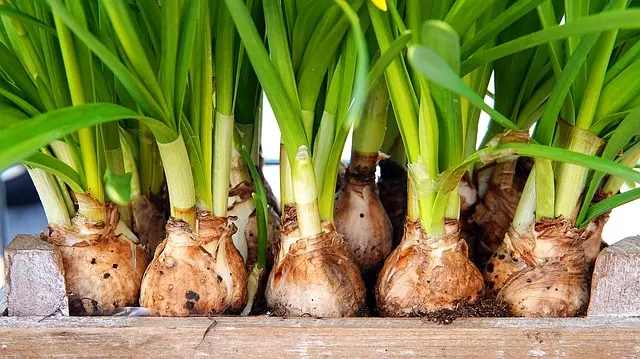
Planting Daffodil Bulbs
When to Fertilize Daffodils
Daffodils do not require abundant fertilization. However, it is advisable to apply a complete fertilizer after harvesting, to replace the depleted nutrients.
Learn more about Different Types of Fertilizers
How Many Daffodil Bulbs Should I Plant Together
Calculate that one-half of a pound of bulb fertilizer on every 25 square feet should be the right amount when planting Daffodil bulbs by the time the stems emerge in spring. Spread the fertilizer around the base of the plants or by following manufacturer instructions.
Water bulbs when they are actively growing in spring. In dry weather conditions, only 1 inch of water every week should be enough.
Cut off the old flower head after it blooms. The leaves and stems naturally turn yellow and naturally dry and then pluck out, usually six weeks after flowering.
The Daffodil bulbs are dug every three to four years in the fall, which is six weeks before the first expected frost. Use a hand-held cultivation fork to loosen the soil, being careful not to puncture the bulb.
Remove Narcissus bulbs from the loose soil. Separate the bulbs and discard any damaged or diseased bulbs. Keep the largest and fattest bulbs for replanting.
Replant Daffodil bulbs on a well-drained bed. Approximately every bulb should be planted at a depth that is twice its length. The bulbs should be about 6 inches (15 cm) apart. After the first frost, spread a 2-inch-thick mulch on the bulb bed to provide soil insulation.
Gradually remove the covering every spring. If the bulb does not show up, apply a high-potassium fertilizer after flowering. When the flowering becomes sparse or the clumps become crowded, lift the clumps and separate them.
- You will receive (1) bag of 50 bulbs
- Spring blooming, fall planting
- Thrives in rich moist soil
Are Daffodils Perennials
Daffodils are perennials when the bulbs remain healthy, whether in the ground or storage conditions. After Daffodil bulbs bloom in spring, enjoy the flowers and let the plants grow. Once the flowers are dry, the Daffodil plants will begin to die and the bulbs can be recovered and stored in suitable conditions for next winter or kept in the ground for next year. They need time after flowering to store energy in the bulbs for rebirth next year.
To remove dead plants, you can cut them back, remove them from the base, or twist the leaves while pulling lightly.
Once the Daffodils flowers have passed, add bone meal to the soil for next year’s blooms.
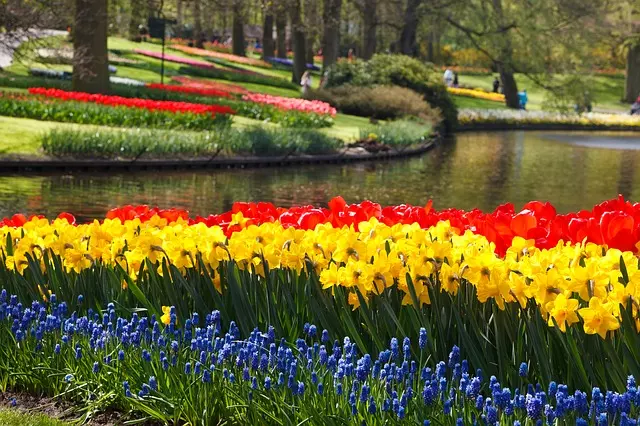
How Long Daffodils Will Bloom
Once in bloom, Daffodils (Narcissus) flowers will remain in bloom for about 4 weeks minimum, to 6-8 weeks depending on the care the plant receives.
When potted Daffodils, place the pot in a place where it can receive direct sunlight for a few hours a day, as well as shade. The place should be protected from strong winds and the temperature should remain stable during the first week at about 59 F (15°C).
Once the plant sprouts its first bud above ground, which happens about a week after planting. You can move it to a much brighter location, as it can now tolerate higher temperatures.
Measuring the moisture of the soil with your fingers or with a small stick, if it is dry, sprinkle a quarter cup of water and let it soak in, let a couple of minutes pass, and check the texture of the soil again if it is still dry add more water.
Continue in this manner until you can see the water in the potting tray. Water it again when you feel that the soil has dried out completely.
Do Daffodils Spread
Daffodil bulbs as many other bulbs will divide, multiple, and spread creating more bulbs. The process occurs in nature when planting Daffodil bulbs on the ground. Although not impossible, the process is difficult to occur in a pot.
When planting Daffodil bulbs in the ground, the bulbs will divide, create little bulbs that will need to be divided in three to five years. When it is in bloom it will be convenient to apply some liquid fertilizer and once the flowers fade, cut, fertilize and continue watering without excesses. During the next months, the plant will offer in the house the beautiful intense green color of its leaves.
When do Daffodils Bloom
Daffodil flowers will bloom early spring-spring. From the end of March, mid-April and early May are possible to see varieties of Daffodil flowers in bloom all across the northern hemisphere. Daffodil flowers will bloom for about 2-8 weeks. This is the time for the Daffodil Festivals.
More bulbs of different flowers, such as tulips, crocus, freesias, etc. will bloom about the same time.
Learn How to Store Tulip Bulbs – Step by Step (With pictures)
Daffodil Festivals
Planting Daffodil bulbs by the end of the fall or early winter, the Daffodil flowers will bloom in the spring. That is when the Daffodil Festivals, the annual Daffodil shows, are on schedule to celebrate Spring.
Nantucket Daffodil Festival in Massachusetts – April
The Daffodil Festival in Puyallup, Washington – April
Camden Daffodil Festival in Arkansas – April
How to Make Daffodil Flowers Bloom Longer
When the warmer months arrive, stop watering completely and wait for the plant to dry out completely. After a week remove the bulbs and store them in a cool place in the dark until planting, preferably the following June and July, for a new forcing.
When the flowers fade cut the flower stalk and let the leaves dry completely. If you need that space to put in another plant, remove the bulbs with soil ball, that is, attached to the roots, and take it somewhere where the leaves can wither.
The mother bulbs are separated and the others are planted as they are. They are then sorted by size and stored on trays in a cool, dry, and dark place.
Once the bulb or other bulbs are planted, the soil should always be kept moist at the root level for good flowering, but not waterlogged so as not to cause rotting. Overwatering is a serious problem for most ornamental plants. It is always better to under-water than over-water.
Bulbs need excellent drainage. Very clayey soils, and therefore with poor drainage, can be made more porous by adding river sand and organic matter (mulch, compost, peat…). If the pot does not have drainage holes in the inferior part or they are insufficient, we must make them.
Water early in the morning or at dusk; not in the sunniest hours. Do not wet the flowers. Therefore, it is not advisable to water with sprinklers or diffusers, but with a drip or hose, locating the water at the foot of the plant.
Continue watering after the flowers have faded so that the leaves continue to accumulate reserves.
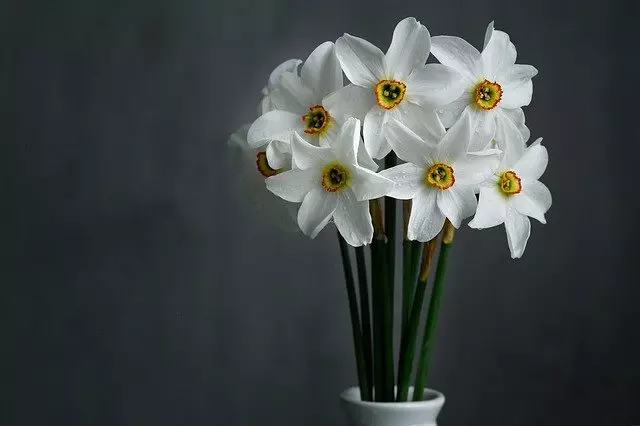
Are Daffodils Poisonous to Cats
All Daffodils are toxic to cats, but the bulbs can be deadly.
When cats eating Daffodils may cause dermatitis and irritation, gastrointestinal problems and vomiting, diarrhea, convulsions, heart disorders, and in extreme cases, death.
Are Daffodils Poisonous to Dogs
All Daffodils are toxic to dogs. Particularly, the bulbs can be deadly for cats and dogs. When dogs eating Daffodil flowers may cause dermatitis and irritation, gastrointestinal problems and vomiting, diarrhea, convulsions, heart disorders, and in extreme cases, death.
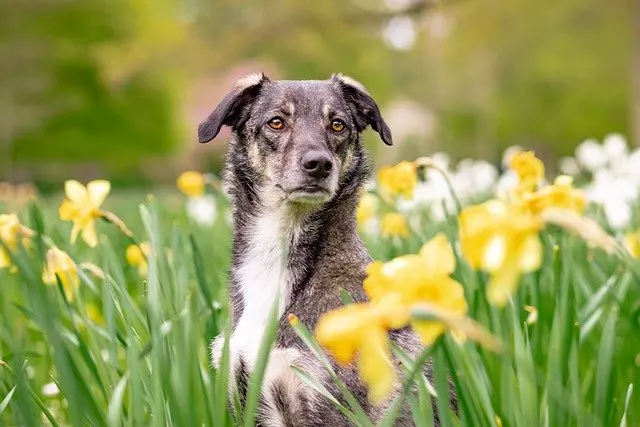
Narcissus Flower
Daffodil Flower
Daffodil Color
– Acropolis: Its flower is white, double, and fragrant; with some red inner petals.
– Birma: flower with yellow and fragrant corolla and orange-red cup.
– Cheerfulness: heavy cream flower.
– Early Splendor: white corolla and orange cup.
– Fortune: yellow corolla and orange-yellow trumpet.
– Flower Carpet: full yellow flower.
– Ice Folies: white corolla and a large yellow-cream cup.
– Margaret Mitchel: white corolla and fragrant. Short yellow cup with a red border.
– Monique: white corolla and orange trumpet.
– Orange Bell: of yellow corolla and big orange trumpet.
– Paperwhite (reed): white and fragrant flower.
– Pink Select: of white corolla and yellow trumpet, deriving to salmon.
– Tahiti: yellow flower, double and fragrant.
Pictures of Daffodils
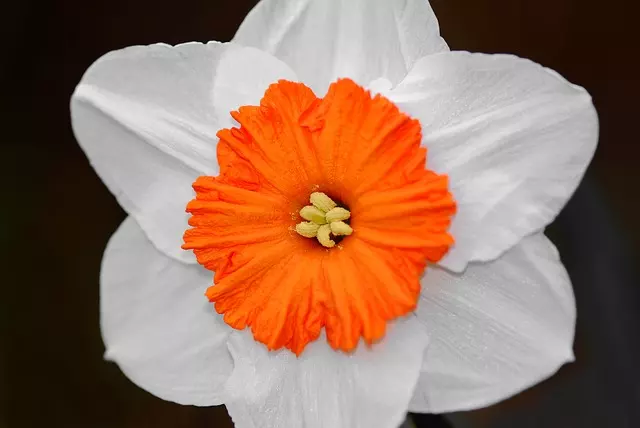
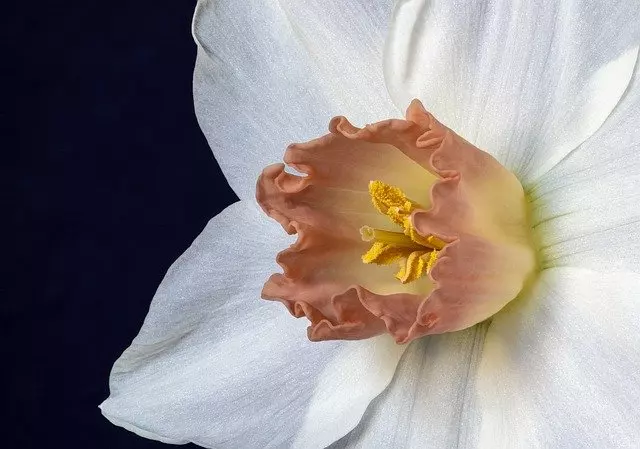
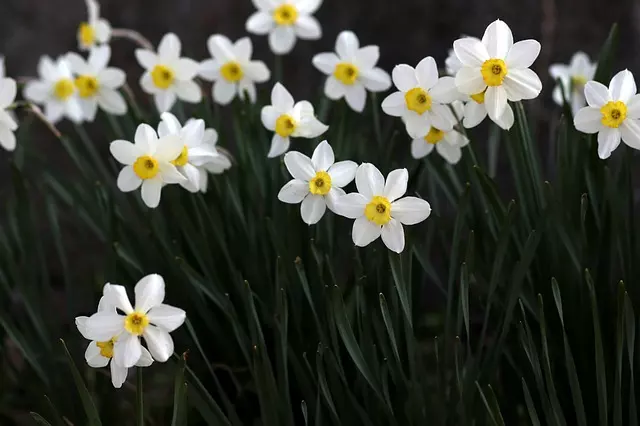
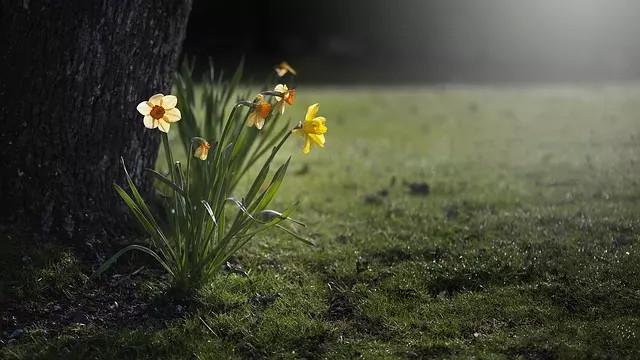
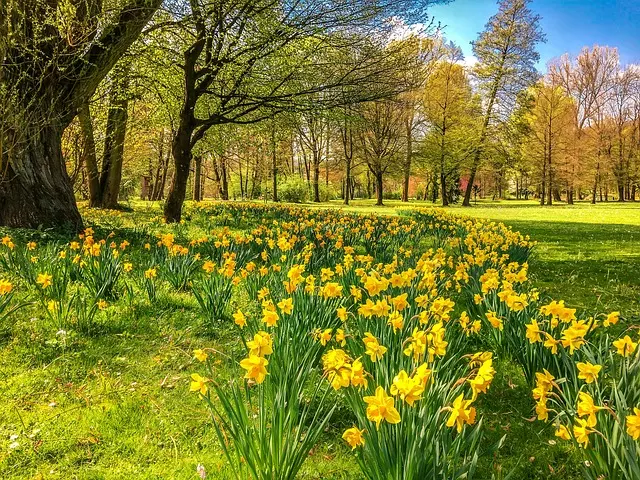
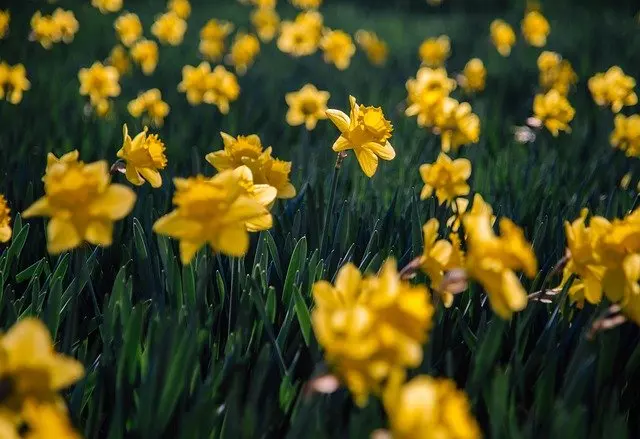
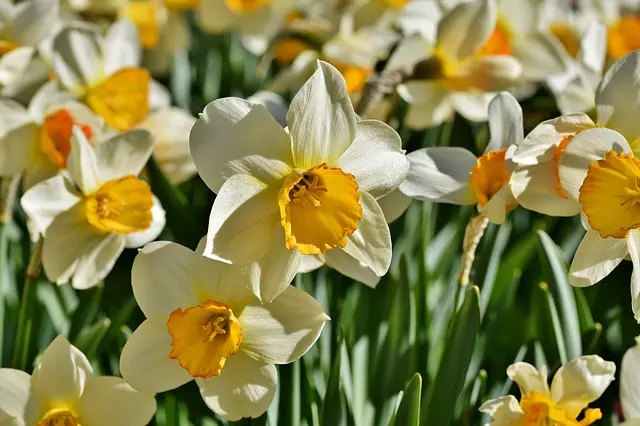
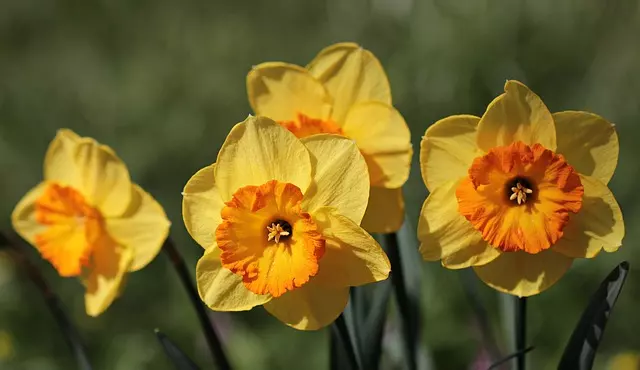
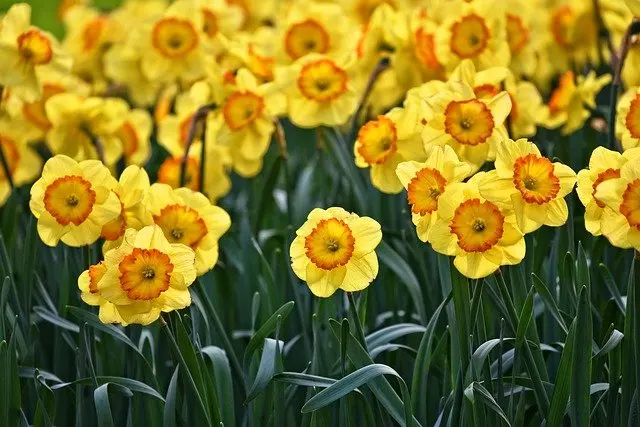
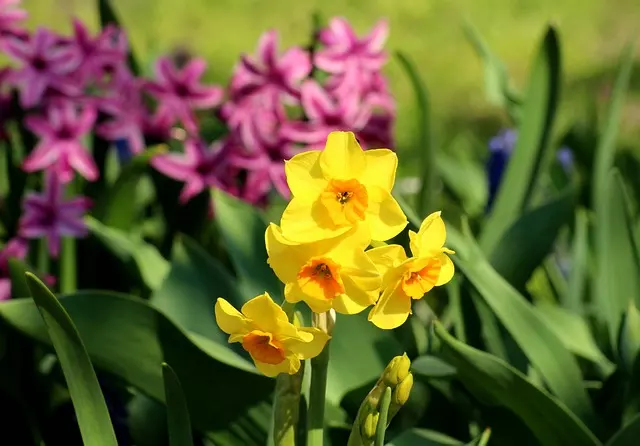
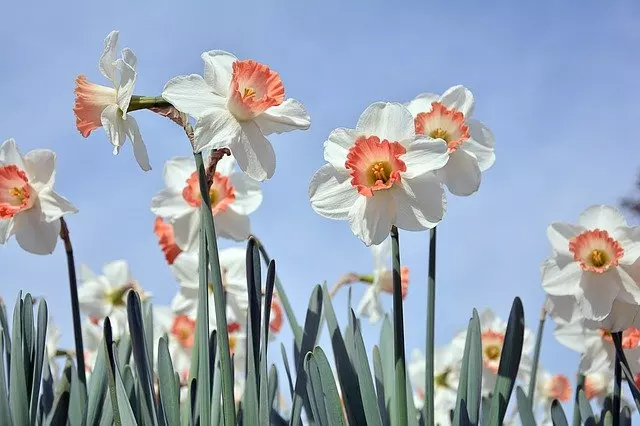
Planting Daffodil Bulbs: Landscaping
The Daffodils find a multitude of applications in landscaping and design these.
For example, naturalizing between meadows and large lawns in gardens, either in isolated groups or forming small groups next to shrubs and planted in rockeries.
They can also be planted in large clay pots in winter, as long as they are protected from the cold, hopefully in dry, dimly lit indoor environments.
Once the seedling has sprouted, it should be provided with a little sun every day. But they are again kept from the cold during the night until they have rooted and grown the stem.
Prevent Pests when Planting Daffodil Bulbs
– Nematodes (Ditylenchus dipsaci): This is a nematode that affects bulbs and tender shoots. The optimum temperature for its development is 59-68 F (15-20ºC), being its activity lower at temperatures below 50 F (10ºC) or above 72 F (22ºC). This nematode survives in the soil and on weeds.
Infestation begins at the base of the bulb and extends to the aerial zone. Symptoms are manifested by stem necrosis, bulging, and reduced growth.
In addition, plants show chlorotic spots and lack vigor. It also causes a decrease in the root system along with poor development of the bulbs.
For its control, a series of preventive measures should be carried out, such as disinfection of bulbs (using hot water for three and a half hours at 110.3 F (43.5ºC) for 15-20 days after harvesting or steam pasteurization, which is the safest and most effective treatment), elimination of affected plants, elimination of weeds that may act as a reservoir, etc.
– Daffodil fly (Merodon ecuestris): This is a pest that appears at the beginning of summer. The larvae penetrate inside the bulbs causing damage by feeding on them. Affected bulbs give rise to deformed shoots, yellowing leaves and finally, the plant weakens.
To control this pest, the bulb should be immersed for 3-4 hours in water at a temperature between 104-122 F (40-50ºC), remove crop residues and weeds, etc.
– Bulb midge (Eumerus sp.): This is a Diptera whose larvae penetrate the bulbs of these plants, feeding on them. They also cause damage to the roots.
For its control, disinfection of bulbs, elimination of crop residues and weeds, etc., is recommended. Biological control of this pest can be carried out by using fungi such as Beauveria bassiana or Entomopthora muscae.
– Aphids: They affect both plants in the vegetative stage and bulbs during their conservation. They usually feed on tender shoots, causing deformations in these. This pest can also transmit viruses, being this the most important damage.
Preventive control for this pest should be important, given its ability to transmit viruses as mentioned above. In greenhouse conditions, the following measures should be taken into account:
– Use of anti-aphid nets.
– Constant monitoring of this pest.
– Elimination of weeds, both inside and outside the greenhouse, since these are major reservoirs of aphids.
– Elimination of symptomatic plants.
Biological control for aphids is carried out by releasing predators such as Coccinella septempunctata and Chrysopa or parasites such as Aphelimus mali. On the other hand, chemical control must be carried out with authorized products that are compatible with the auxiliary fauna, before the plant suffers significant damage.
– Tarsonemus laticeps: These are mites that inhabit the bulb tunics. This pest affects the basal leaves, but later invades the rest of the plant causing chlorosis.
– Daffodil galeruca (Exosoma lusitania): The larvae of E. lusitania cause damage to the bulb by feeding on them, causing galleries and rotting, while the adults feed on the aerial part of the daffodil.
For their control, treatments with an authorized insecticide must be carried out.
Prevent Diseases when Planting Daffodil Bulbs
– Neck rot (Fusarium sp.): This fungus affects both the roots and the base of the narcissus stem, causing a reddish-brown dry rot. As a consequence, the aerial symptoms are usually leaf chlorosis, reduced flower bud development, and wilting of the plant.
To avoid the incidence of diseases, crop rotation for five years, rapid drying of corms, liming of soils, and preventive treatments with authorized chemical products are recommended.
– Penicillium sp.: This is a fungus that appears mainly during storage, as it proliferates at temperatures below 63 F (17ºC) and high relative humidity. Symptoms are manifested by the appearance of necrotic spots on the bulb scales. Below this zone, it acquires a brownish color that turns into a whitish color with a spongy texture. Affected bulbs give rise to short shoots.
To avoid the incidence of this fungus, an adequate temperature and ventilation should be maintained during storage, as well as a relative humidity below 70%.
– Botrytis cinerea: This is a fungus that needs wounded or senescent tissues to affect the plant, as well as environmental humidity and high temperature. It causes the appearance of gray mycelium on leaves, stems, and flowers.
Control of this particular fungus is important. Excessive humidity should be avoided, either by reducing the dose and frequency of irrigation, spacing the plants, or ventilating. It is also advisable to remove diseased tissues, cutting them at stem level and using disinfected tools. When the attack is drastic or damaging it needs to apply chemical control. Alternate use of the different systemic groups of authorized products is recommended.
– Rust (Puccinia sp.): Appears at temperatures between 59-70 F (15-21ºC). Yellow spots on the upper side of the leaf are one of the symptoms. Then, the center of the spot turns brownish. On the underside, yellow waxy pustules appear, which later turn pink and finally white.
To control this disease, infected plants should be eliminated, avoid wetting the foliage, encourage ventilation, and avoid excess nitrogen. If the attack is severe, treatments with authorized fungicides are recommended.
– Septoria (Septoria sp.): Symptoms appear as brownish-yellow spots on leaves, which become covered with white mold. Subsequently, they end up wilting.
To control it, bulbs must be disinfected, symptomatic plants must be eliminated, etc.
– Heterosporiosis (Heterosporium sp.): This is a fungus that affects leaves, stems, and flowers. Symptoms are manifested by the appearance of brown spots with a rounded appearance, which are delimited by a reddish border. Spores appear in the center of these spots (more protruding spots). The recommended control for this disease is similar to that carried out for Septoria.
Daffodil Drawing
Nowadays, the drawing of Daffodil flowers has gained importance in contemporary art and seems to be good therapy to focus our thoughts and contribute to relieving our stress.
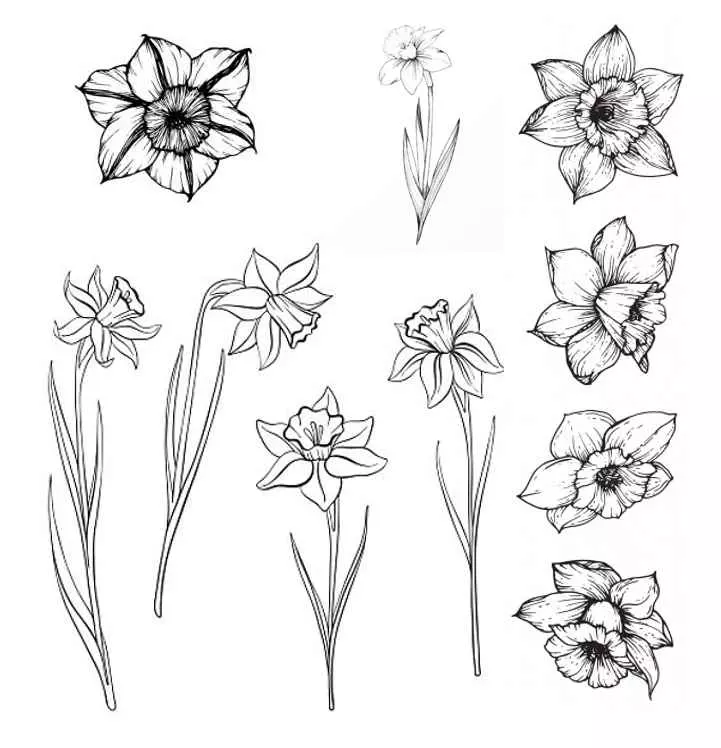
Narcissus Flower Tattoo
Daffodil Tattoo
Being such a beautiful and fragrant flower, daffodils are associated with all things beautiful. What better than to leave that imprint of beauty on our skin!
For those who want to try temporary tattoos of short duration, there are plenty of absolutely beautiful temporary tattoos of Daffodils. Check out this website with temporary Daffodil Tattoos or check here.
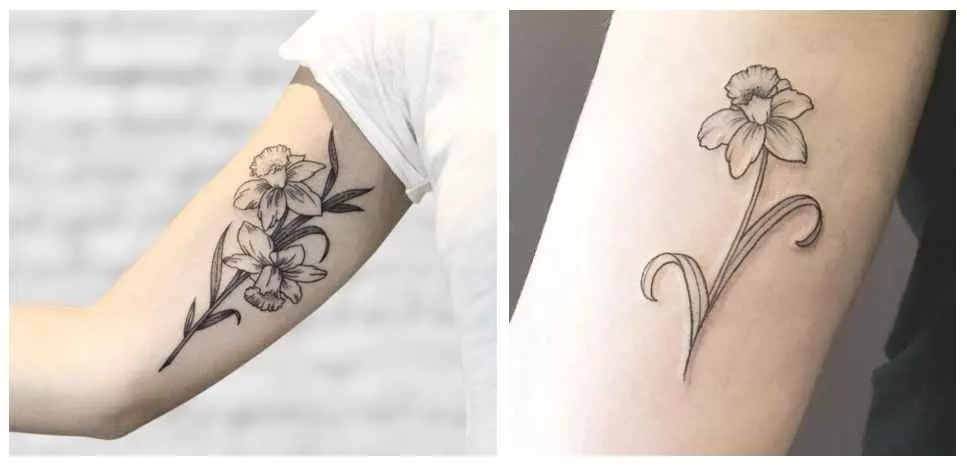
Pictures of Daffodil Flowers

